Airport Traffic Ranks
Here's the latest chart comparing aircraft traffic at major US and Canadian airports before and after the COVID-19 crisis. These stats include virtually all commercial passenger and cargo aircraft, but excludes most military traffic and general aviation where the operators have opted out of public tracking.
Yesterday's busiest airports were DFW, ORD, MEM, ATL, CLT, DEN, LAX, SDF, PHX, and ANC. MEM, SDF, and ANC bumped EWR, BOS, and IAH out of the pre-crisis top ten.
Air traffic at Memphis was down 16%, which is relatively strong compared to the losses suffered at passenger-focused airports. FedEx is the largest cargo airline in the world, and the SuperPort at Memphis is their main hub. FedEx traffic has been growing modestly since the crisis began.
Similarly, UPS has been experiencing some growth in the number of flights operated, which has bumped their Louisville hub into the ten busiest airports in the US and Canada. Overall traffic at SDF was down 22%.
Amazingly, Anchorage has actually seen an increase in the number of flights being operated there, the only airport in the top 50 to have done so. Many freighters flying between Asia and North America stop in ANC for fuel and crews.

Traffic Graphs
Air traffic across the US and Canada still hasn't bottomed out; Air Canada, American, GoJet, SkyWest, Mesa hit new post-crisis lows, as did IAH, JFK and SFO. Mainline US and Canada airline traffic is down 76%.
The most interesting story being told by the stats continues to be the relatively slow response of Southwest, though they're starting to catch up to the other big carriers.
FedEx and UPS are also doing very well, up 9% and 12% respectively compared to pre-crisis Tuesdays, which is a pretty strong performance on what is traditionally their busiest day of the week.
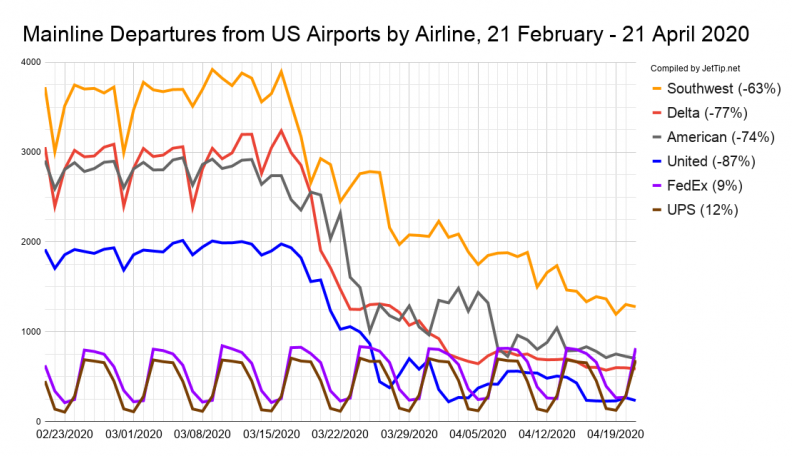
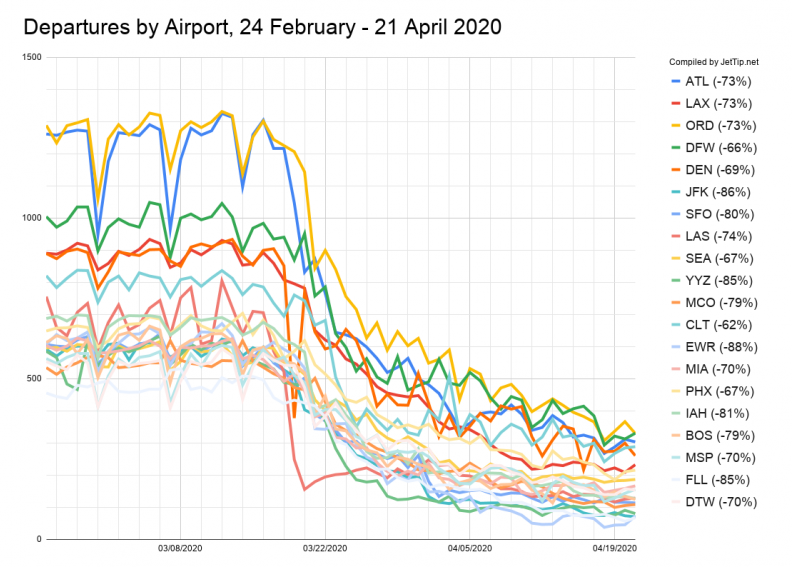
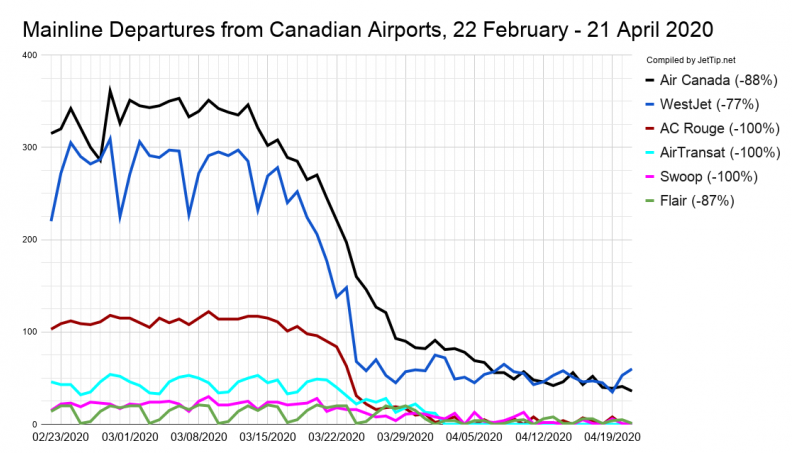
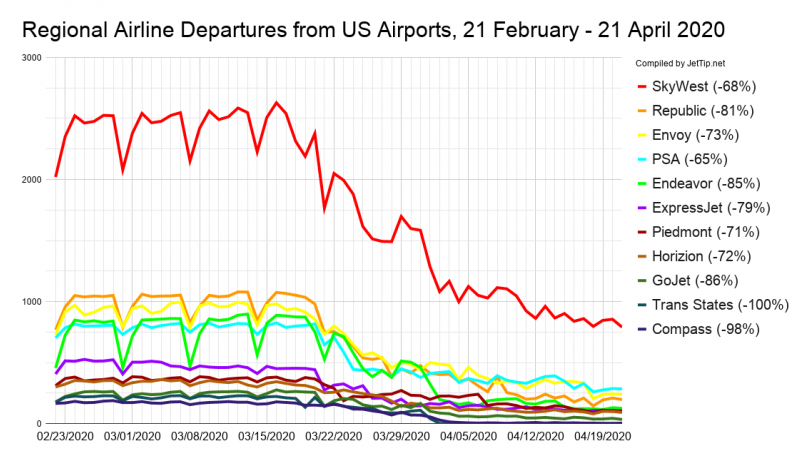
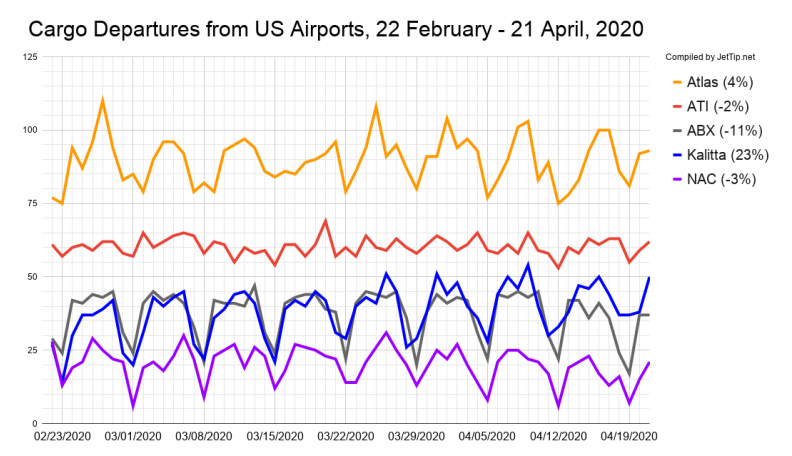

News from Elsewhere
- Airbus and Boeing hustle to keep airplanes flowing to a collapsed market (including the nugget about Delta's proposed 717 for 737 MAX swap); Jon Ostrower, The Air Current
- Delta to Retire MD-88s; Kyle Potter
- Antonov Airlines begins a series of flights to deliver medical supplies from China to USA
- United Airlines Town Hall Notes; Chris Sloan
- Live Airshow TV's Socially Distant Air Show
- FAA ATC issue near Washington DC; Ethan Klapper
- DOT denies reasonable exemption request from Silver Airways; Seth Miller
- Delta announces March Quarter 2020 financial results and COVID-19 response actions
Additional Aviation News Resources
If you're looking to keep tabs on what's going on, there are lots of great places to be keeping track of aviation news.
- JetTip's Aviation News list with tweets from generally reliable sources
- JetTip's realtime diversion tracking page
- Coronavirus Flight Cancelation Tracker
- TSA Sreening Volume
- The Air Current
- PaxEx.Aero
- Cranky Flier's Daily Update
- Ethan Klapper's Bluer Skies
Methodology: Departures by Airline Since Late February
COVID-19 started impacting aviation in China at the end of January, which also impacted the US and Canadian routes to Asia, but large differences in the number of flights being operated by carriers on this side of the Pacific didn't really start adding up until a couple of weeks ago. A few places had been sharing global trends, but I was selfishly interested in an airline by airline breakdown of how significant the impact had been.
The methodology here is to count all flights between 12:00:00 AM and 11:59:59 PM eastern time that departed from an airport in the airline's respective home country (Delta departures from US airports, WestJet departures from Canadian airports, etc.). Since commercial airline schedules are highly cyclical, the percent change is derived by comparing the specified day's count compared to the average of the number of flights each airline operated during three previous "pre-crisis" weeks, 22 February - 13 March.

Nick Benson
Nick lives in Burnsville, Minnesota with his wife and three children. He grooves on railroad and aviation photography, politics, geography, weather, and LEGO. He started JetTip's smart flight alert service in 2017, and is now a full-time avgeek. He can frequently be found atop a step ladder at MSP's Aircraft Viewing Area.
Recent Posts
2024 AvGeek Calendar: Airliners Internaitonal MCI in June; SpotLAX in September
NFL 2023 - conference championship round team charter flights
NFL 2023 - divisional round team charter flights
NFL 2023 - wild card team charter flights
NFL 2023 - week 18 team charter flights
News
JetTip Features, Trip Report, Special Liveries, Events, COVID-19, Press Releases
Airline
Delta, Icelanndair, Sun Country, UPS Airlines